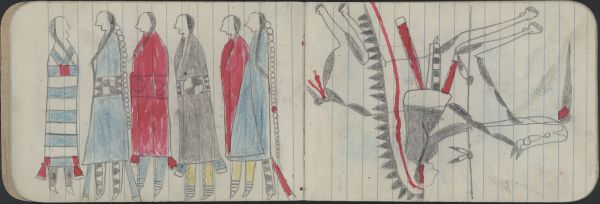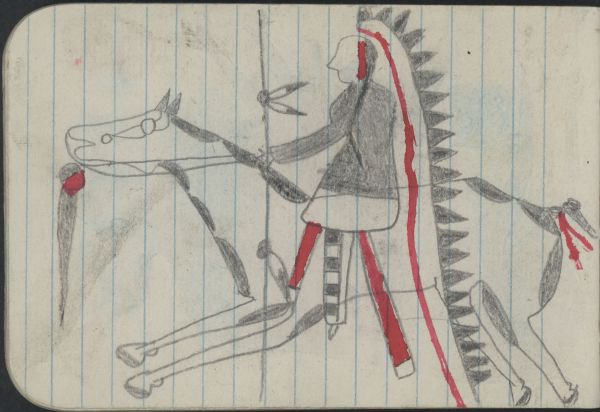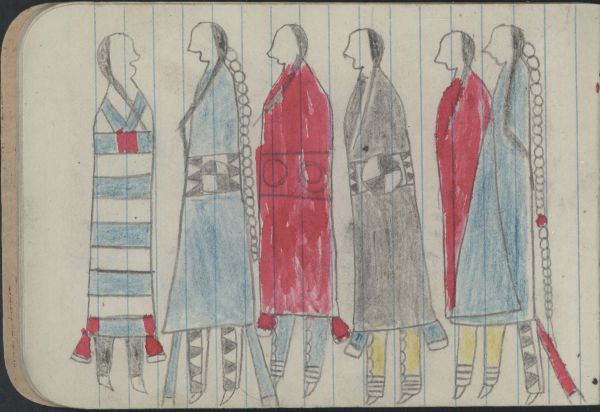COURTING: 2 Men and 4 Women (in Blue, Black, Red, 2nd Phase Navajo Chief's Blanket); WAR, WARRIOR: Man ion White-and-gray pinto Carries a Lance
Ethnographic Notes
16 COURTSHIP: GROUP. A group of six: Two men and four women. The man on the right wears a blue blanket of Stroud trade cloth. His hairplate ornament attached to his scalplock extends almost to the ground. His braid ends with an attached tie. His long breech clout, touching the ground, is red cloth with a white edge (undyed selvedge). His beaded leggings have a jagged "lightning" design. The beadwork on leggings of both men have black-and-white war designs (see Michael Cowdrey's Arrow's Elk Society Ledger, 1999: 209). He stands beside a woman in a red blanket with yellow-colored leggings, probably buckskin. She has four bands around each ankle. The next woman wears a dark blanket with a medicine-wheel design courtship blanket. Her leggings are also yellow for buckskin, with a row of German silver small conchos running vertically up the front. Her dress panels showing beneath the blanket are blue. The next woman wears a red blanket with outlines of two circles on the center strip. Next is a man who wears a blue blanket with beaded medicine-wheel design on the center strip. His German silver hairplate ornament is shorter than the first man�s. His blue clout also reaches the ground. His braid ends with a black tie. The woman farthest to the left wears a second-phase Navajo chief's blanket, red panels of her dress show beneath the blanket. Her leggings are simple dark cloth. She is the only figure facing to the right, apparently in relationship with the man. See plate 1 for further discussion of courtship conventions. Color symbolism was important to Cheyenne ledger artists. The colors black and blue were feminine. Michael Cowdrey writes about the persistent occurrence of the color dyad of red and black: "Red symbolizes the sun, the phallus, and all things masculine; black denotes night and death, the womb, and all things feminine" (1999: 46). Imre Nagy also describes the duality of masculine and feminine as an ever-present dynamic, where balance is constantly moving between the two spheres ("Cheyenne Shields and Their Cosmological Background," American Indian Art Magazine 19.3 [summer 1994]: 40). Greene notes the importance of contrast for syntactical meaning (1985: 67). Throughout the ledgers, blue (or black) contrasts with red. 17 reversed WAR, WARRIOR. The warrior on dark-colored (lead pencil) pinto wears a full eagle headdress with immature golden eagle feather mounted on a red strip of cloth, forming one trail. His face is painted red, vertically along the hairline. He carries a lance with four immature golden eagle feathers (two pairs) tied to the shaft, as well as two circular ornaments of clipped feathers. His shirt is gray and leggings have a black-and-white box design. The alternating blocks of black-and-white beadwork that edge his leggings are "old" and "sacred" (Powell, Sacred Mountain: 564); this design appears often on war shirts and leggings (Lanford, 2003: 153, Fig. 15; Cowdrey, 1999: 209). A light-colored blanket is around his torso. Richard Irving Dodge (Thirty-Three Years among Our Wild Indians 339) describes horseback travel dress: "One blanket or robe is around the rider's person, and he sits on another one if he has it." The horse is prepared for war, with scalp tied on reins to hang under his mouth; silver headstall, and his tail is tied with red cloth. The scalp is mounted on a circular black-and-red hoop. Michael Cowdrey writes about scalps hung near a horse's mouth on its "war bridle": "...scalps suspended near the mouth denote that these Thunderhorses will literally devour the enemy" (1999: 46). Benson L. Lanford writes of this practice: "A Victorious Warrior might hang a scalp that he had taken on the horse that had carried him into battle. The scalp conveyed to everyone the honor that he shared with his mount" (The Cheyenne/ Arapaho Ledger from the Pamplin Collection, 2003: 189). It wears a silver or German silver headstall (Kahn, 2003: 72, 81). This particular warrior or a close comrade is repeated in this ledger, wearing the same distinctive war bonnet, in plates. See Plate 9 for further discussion.


